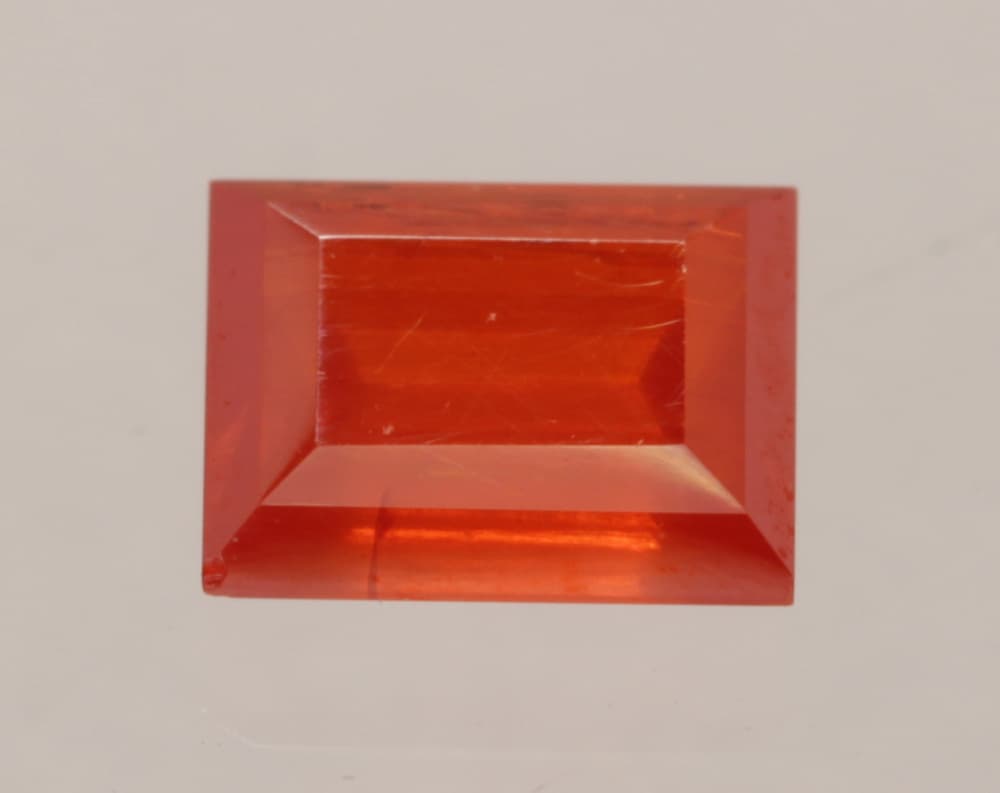Crocoite Value, Price, and Jewelry Information
Lovely saffron-colored crocoite is quite a rare mineral. Although too soft and brittle for jewelry wear, a few crystals have been faceted for collectors.
1 Minute Read
Lovely saffron-colored crocoite is quite a rare mineral. Although too soft and brittle for jewelry wear, a few crystals have been faceted for collectors.
Start an IGS Membership today
for full access to our price guide (updated monthly).Crocoite Value
Comments
This mineral was previously named crocoise and later crocoisite and is also known as red lead ore.
Tasmania, Australia declared crocoite its official state mineral in 2000.
This rough and cut set features a specimen of lustrous, red-orange crocoite crystals on matrix and a rectangle-cut crocoite gem. 4.5 x 3.3 x 2.1 cm (specimen); 0.58 cts, 4.36 x 3.70 mm (gem); Dundas, Zeehan District, Tasmania, Australia. © Rob Lavinsky, www.iRocks.com. Used with permission.
Identifying Characteristics
Crocoite's intense red-orange to yellow-orange color completely masks its high dispersion.
Crocoite has an orange-yellow streak. Please note: don't conduct streak testing on finished gems. Test material in inconspicuous spots as a last resort only.
This mineral shows a distinct absorption band at 5550 but only in thin fragment specimens. It transmits light mainly in the yellow-red region of the spectrum.
Synthetics
Synthetic lead(II) chromate, or "chrome yellow," has the same chemical formula as crocoite but is only used as a pigment. There's no known jewelry use for this material.
Treatments
No known treatments or enhancements.
Sources
Dundas, Tasmania produces the world's best crystals (some gemmy) in large clusters.
The Berezovsk District in Russia, the type locality, produces red crystals.
Other notable sources for gem-quality material include the following:
- United States: Tiger, Arizona (very tiny crystals); California.
- Brazil: Minas Gerais.
- Germany.
Stone Sizes
Gems can weigh up to about 10 carats. However, these are usually not transparent. Tasmania can produce clean, deep red-orange stones up to 1-2 carats.
- Devonian Group (Calgary, Alberta, Canada): 14.5 (orange, Tasmania).
- Smithsonian Institution (Washington, DC): 5.7 (orange-red, Tasmania).
Care
With a hardness range of 2.5 to 3, crocoites could be cut by coins and knives. Therefore, jewelry use isn't recommended. For storage suggestions and other information, consult our gemstone collection guide.
Although this mineral contains hexavalent chromium and lead, both toxic, handling crystals or finished gems should pose no problems. However, when cutting this material, avoid ingesting or inhaling particles, wash your hands, and don't pour solutions with this material down the drain. For more information, consult our articles on toxic and radioactive gem materials and health hazards and safety tips for gem cutters.
Joel E. Arem, Ph.D., FGA
Dr. Joel E. Arem has more than 60 years of experience in the world of gems and minerals. After obtaining his Ph.D. in Mineralogy from Harvard University, he has published numerous books that are still among the most widely used references and guidebooks on crystals, gems and minerals in the world.
Co-founder and President of numerous organizations, Dr. Arem has enjoyed a lifelong career in mineralogy and gemology. He has been a Smithsonian scientist and Curator, a consultant to many well-known companies and institutions, and a prolific author and speaker. Although his main activities have been as a gem cutter and dealer, his focus has always been education.
International Gem Society
Related Articles
Unique Gem Materials for Jewelry Design
Celestite Value, Price, and Jewelry Information
Periclase Value, Price, and Jewelry Information
Chromite Value, Price, and Jewelry Information
Never Stop Learning
When you join the IGS community, you get trusted diamond & gemstone information when you need it.
Get Gemology Insights
Get started with the International Gem Society’s free guide to gemstone identification. Join our weekly newsletter & get a free copy of the Gem ID Checklist!
